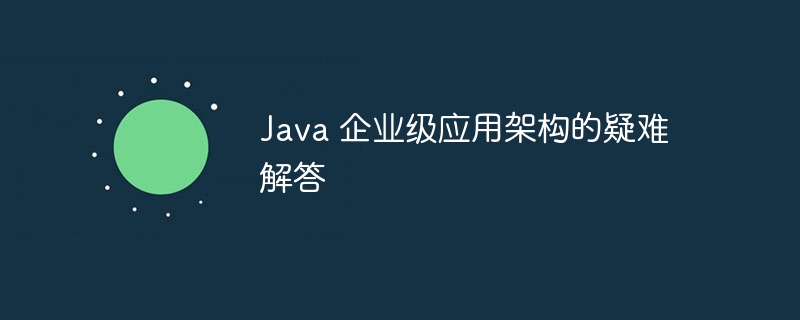Home >Java >javaTutorial >Troubleshooting Java enterprise application architecture
Troubleshooting Java enterprise application architecture
- WBOYWBOYWBOYWBOYWBOYWBOYWBOYWBOYWBOYWBOYWBOYWBOYWBOriginal
- 2024-05-07 09:33:01853browse
When building Java enterprise-level applications, it is crucial to choose a reasonable architectural pattern: Architecture pattern: n-tier architecture is used to decompose applications, microservice architecture decomposes applications into independent services, and domain-driven design is based on business Domain modeling. Concurrency and scalability: Use distributed transactions, message queues, and load balancers to handle concurrency and improve scalability. High Availability: Ensure application availability in the event of failure through clustering, replication, and automated failure recovery. Performance optimization: Use caching, database indexing, and code optimization to improve application performance. Security: Implement authentication and authorization, input validation, and encryption to protect applications and data from security threats.

Troubleshooting Java Enterprise Application Architecture
When building complex Java enterprise applications, architecture choice is crucial important. Here are some common troubleshooting questions to help you plan and build scalable, performant, and maintainable applications.
Question 1: Which architecture mode to choose?
- n Layer architecture: Common application architecture used to decompose the application into a presentation layer, a business logic layer and a data access layer.
- Microservice architecture: Decompose the application into smaller, independent services, each service is responsible for a specific function.
- Domain-driven design (DDD): An architectural approach that emphasizes application modeling based on business domains.
Practical case: An online retail application can use an n-tier architecture, in which the presentation layer is responsible for the user interface, the business logic layer handles order management, and the data access layer interacts with the database .
Question 2: How to deal with concurrency and scalability?
- Distributed transactions: Handles concurrency in distributed systems by ensuring that multiple transactions commit or rollback together.
- Message Queuing: Allows applications to handle requests asynchronously, thereby improving scalability.
- Load Balancer: Distribute requests to multiple servers to improve performance and availability.
Practical case: An order processing application can use message queues to queue received orders and process them in parallel on multiple servers to cope with traffic peaks.
Question 3: How to achieve high availability?
- Cluster: Deploy multiple application instances and provide failover if one of the instances fails.
- Replication: Replicate data to multiple locations so that it is still accessible if one of the locations fails.
- Automatic failure recovery: A mechanism to automatically restart or restore services when an application fails.
Practical case: A customer-facing web application can use a cluster to continue providing services in the event of a server outage.
Question 4: How to optimize performance?
- Cache: Store data in memory to increase access speed.
- Database index: Create an index to speed up queries to the database.
- Code optimization: Use efficient data structures and algorithms to reduce execution time.
Practical case: An e-commerce website that frequently searches for products can use cache to store recently searched products to provide search results more quickly.
Question 5: How to ensure security?
- Authentication and Authorization: Ensures that only authorized users can access applications and data.
- Input Validation: Validate user input to prevent injection attacks.
- Encryption: Protect sensitive data from unauthorized access.
Practical case: A banking application can use authentication and authorization to prevent unauthorized users from accessing customer accounts.
The above is the detailed content of Troubleshooting Java enterprise application architecture. For more information, please follow other related articles on the PHP Chinese website!
Related articles
See more- Detailed explanation of the three data access methods of PHP object-oriented (code examples)
- How PHP applications use Memcache caching technology to improve data access speed
- PHP security protection: avoid sensitive data leakage
- PHP and SQLite: How to deal with sensitive data and security issues
- API Authentication and Authorization with Laravel: Protecting Sensitive Data and Operations

